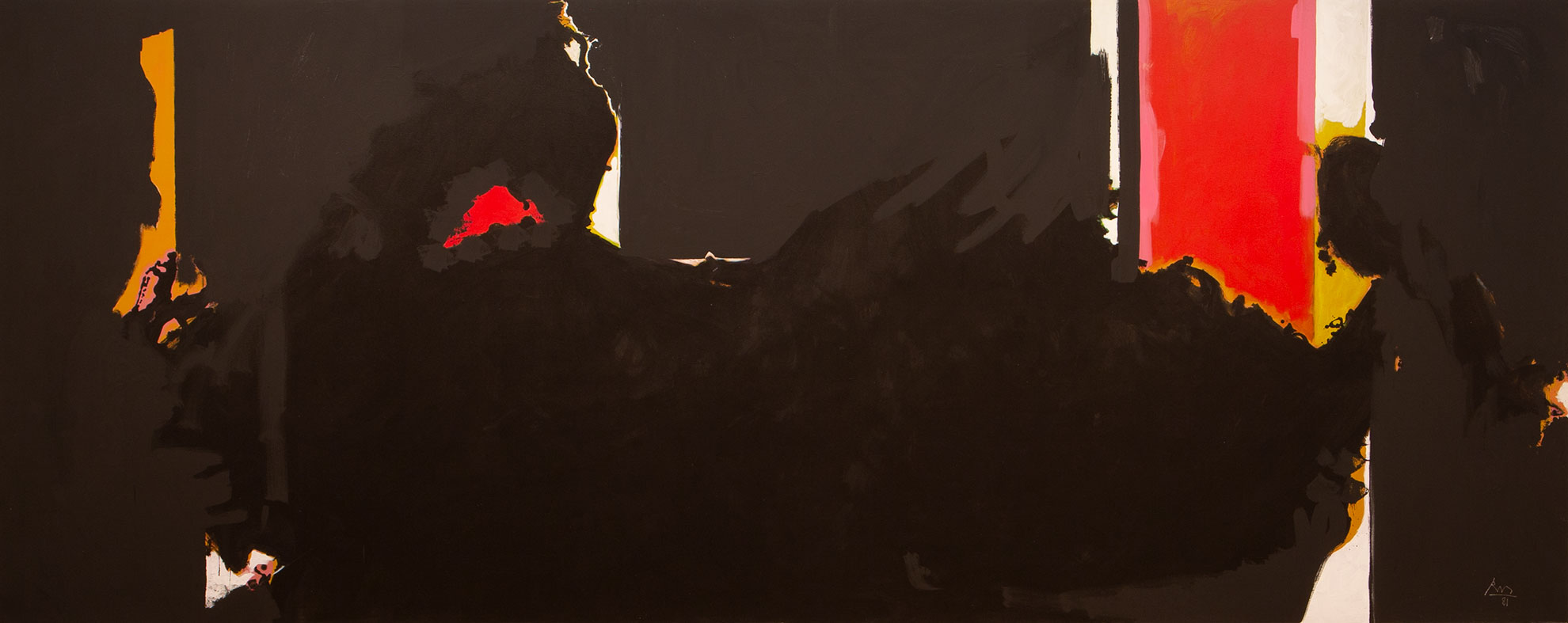Robert Motherwell from the Collection: 1941–1990

Robert Motherwell
Face of the Night (For Octavio Paz), 1981
Acrylic on canvas
72 x 1803/8 inches
Collection of the Modern Art Museum of Fort Worth, Museum purchase, The Friends of Art Endowment Fund
One of the Museum's most significant holdings is its comprehensive collection of works by Robert Motherwell. Numbering fifty objects—paintings, collages, prints, and sketches—this body of work offers a special opportunity to examine and appreciate the creative range of this major modernist artist. Robert Motherwell is one of the figureheads of Abstract Expressionism, arguably the most important movement in the history of American art. This movement is further represented in the Museum's collection by the works of Jackson Pollock, Mark Rothko, Clyfford Still, William Baziotes, Franz Kline, and Adolph Gottlieb. More than any other artist of the group, Motherwell passionately and intelligently articulated the basis for and possibilities of modernist abstract art.
The youngest of the Abstract Expressionists, Robert Motherwell was born in Aberdeen, Washington, in 1915 and studied philosophy in the 1930s at Stanford University and Harvard University. After spending time in France and working as an artist, he returned to enter a doctoral program in art history at Columbia University in 1939. While at Columbia, Motherwell was encouraged to paint by his professor Meyer Schapiro. Schapiro also introduced his student to several Surrealist painters working in New York. In 1941, Motherwell traveled to Mexico with the Surrealist Roberto Matta Echaurren. Matta introduced him to the Surrealists' process of psychic automatism, spontaneous drawing or writing that flowed, unedited, from the artist’s unconscious. For Motherwell, automatism (in the artist's words, "artful scribbling") became what he called his lifelong "creative principle" and profoundly affected his future work.
In the late 1940s, Motherwell embraced the tenets associated with the Abstract Expressionist movement: the canvas as an arena in which the artist engages spontaneously and passionately in the physical and mental action of painting; the composition, often monumental in size, charged with feeling; the abstract forms suggesting deep, open-ended meanings. In his essay "A Personal Expression," he wrote, "Art is a form of action, a drama, a process. It is the dramatic gesture itself in modern times, not a religious content, that accounts for art’s hold on the minds of men."
As a major force in American art for nearly fifty years, Motherwell enjoyed international stature as a painter, collagist, and printmaker. Robert Motherwell from the Collection: 1941–1990, drawn exclusively from the Museum's own holdings, will chart the complete range of the artist's career, with works dating from as early as 1941 to 1990, the year before his death. All of the artist's most important series will be represented, including his famous Elegies to the Spanish Republic and his Open works, as well as rarer, lesser-known series such as the Iberia paintings.
The Elegies to the Spanish Republic, which began to take form in the early 1950s, constitute one of the key series in Motherwell's prolific career. Although they were inspired by the Spanish Civil War, these works are by no means intended as illustrations of the conflict. For Motherwell, they are less history paintings and more memorials. He wrote, "The pictures are general metaphors of the contrast between life and death, and their interrelation." The artist used Spain's tragic social and political conflict as a starting point for the creation of what has become his hallmark, a dramatic series of images relying consistently on the contrast of ovals and rectangles and black and white.
The Open series is also crucial for a complete understanding of Motherwell's work. He began the Opens in 1967, responding to the impulse in European and American visual arts to regard painting as a window. The notion of the window had figured into his work from the beginning of his career, as early as 1941, when he painted the Museum's Spanish Picture with Window. The Open series represents Motherwell's joining of his longstanding interest in the window with his new notion of how to a make a painting. Each of the Open works, which are characterized by sparse visual components and serene, uncomplicated color, contain a charcoal-delineated rectangle (or three-sided rectangle), which the artist acknowledged partially derived from whitewashed adobe facades. He said, "I've always loved Spanish houses with those big, plain, stark facades, with a dark doorway cut out of the expanse, or say, two windows beautifully cut out of a magnificent whitewashed wall."
Throughout his career, the artist worked in series, and often the compositions from one series affected those in another. Stephen's Iron Crown, 1981, is part of a group of paintings — all bearing titles that refer to James Joyce — that the artist produced in 1981. These pictures were based on a 1979 series of oil-on-paper paintings, Drunk with Turpentine, which Motherwell had generated by the process of automatism. In these works, the artist thinned oil paint with turpentine to the consistency of ink and spontaneously let the work, in his words, "pour out."
Along with his paintings, Motherwell produced prints and collages. An impressive example is the Museum's Je t'aime with Gauloise Blue, 1976. For this abstract painter, collage offered a means of incorporating elements of the everyday world into his art and producing, as he put it, "a modern substitute for still life." By appropriating random scraps from his studio, he engaged in a playfulness not evident in most of his paintings. Collage offered a certain intellectual creative relief by providing the artist a way of "dealing with those things that do not originate in me, in my I."
Robert Motherwell
Face of the Night (For Octavio Paz), 1981
Acrylic on canvas
72 x 1803/8 inches
Collection of the Modern Art Museum of Fort Worth, Museum purchase, The Friends of Art Endowment Fund
